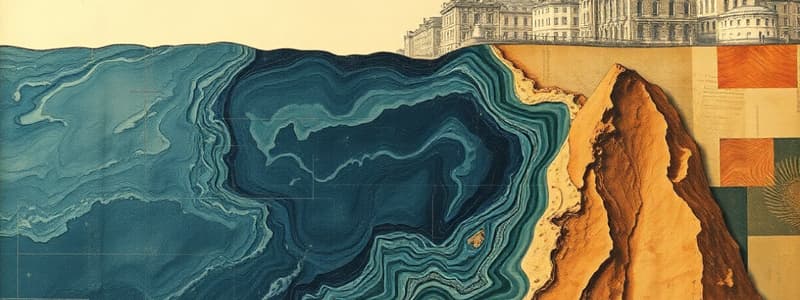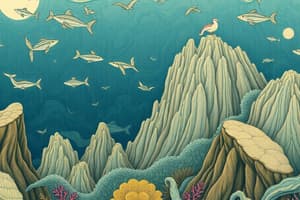Podcast
Questions and Answers
Which geological process is primarily responsible for the creation of mid-ocean ridges?
Which geological process is primarily responsible for the creation of mid-ocean ridges?
- Seafloor spreading at plate boundaries (correct)
- Subduction of tectonic plates
- Volcanic activity from mantle plumes
- Continental weathering and erosion
In what order are the five major ocean basins typically listed, from largest to smallest?
In what order are the five major ocean basins typically listed, from largest to smallest?
- Atlantic, Pacific, Indian, Arctic, Southern
- Atlantic, Indian, Pacific, Southern, Arctic
- Pacific, Indian, Atlantic, Arctic, Southern
- Pacific, Atlantic, Indian, Southern, Arctic (correct)
What term describes the comprehensive mapping and study of the ocean floor's shape and features?
What term describes the comprehensive mapping and study of the ocean floor's shape and features?
- Oceanography
- Bathymetry (correct)
- Hydrology
- Topography
Which of the following is NOT considered a primary feature found on the abyssal plain of an ocean basin?
Which of the following is NOT considered a primary feature found on the abyssal plain of an ocean basin?
Besides seafloor spreading, what is another major plate tectonic activity responsible for the formation of many ocean basins?
Besides seafloor spreading, what is another major plate tectonic activity responsible for the formation of many ocean basins?
What geological process is primarily responsible for the initial formation of the Atlantic Ocean?
What geological process is primarily responsible for the initial formation of the Atlantic Ocean?
Which characteristic primarily distinguishes an active continental margin from an inactive continental margin?
Which characteristic primarily distinguishes an active continental margin from an inactive continental margin?
Abyssal plains in inactive ocean basins are largely formed due to the accumulation of which type of material?
Abyssal plains in inactive ocean basins are largely formed due to the accumulation of which type of material?
How does the rate of seafloor spreading affect the topography of an oceanic ridge?
How does the rate of seafloor spreading affect the topography of an oceanic ridge?
What is the primary difference between a seamount and a guyot, both being types of inactive volcanoes?
What is the primary difference between a seamount and a guyot, both being types of inactive volcanoes?
Flashcards
What is an Ocean Basin?
What is an Ocean Basin?
A large, bowl-shaped depression in the Earth's surface that is filled with water, formed by geological processes.
Continental Shelves
Continental Shelves
The edges of ocean basins are called continental shelves. They are flat, shallow areas that extend from the coast.
Continental Slope
Continental Slope
The steep slope that marks the transition from the continental shelf to the deep ocean floor.
Seafloor Spreading
Seafloor Spreading
Signup and view all the flashcards
Mid-Ocean Ridges
Mid-Ocean Ridges
Signup and view all the flashcards
Oceanic Ridges
Oceanic Ridges
Signup and view all the flashcards
Abyssal Hill
Abyssal Hill
Signup and view all the flashcards
Seamount
Seamount
Signup and view all the flashcards
Guyot
Guyot
Signup and view all the flashcards
Ocean Trenches
Ocean Trenches
Signup and view all the flashcards
Study Notes
Ocean Basins: Formation and Features
- Ocean basins are bowl-shaped depressions formed by geological forces (weathering, erosion, plate tectonics)
- Five major ocean basins: Pacific, Atlantic, Indian, Southern (Antarctic), Arctic
- Collectively known as the world ocean, covering ~70% of Earth's surface
- Smaller basins exist between larger ones (e.g., North Aleutian Basin)
- Bathymetry describes the ocean floor's shape
- Continental shelves, slopes, and rises form the basin's rim, declining to the abyssal plains
- Abyssal plains contain oceanic ridges (abyssal hills, guyots, seamounts) and trenches
- Oceanographers use submersibles to study deep trenches due to water pressure and cold temperatures
Formation of Ocean Basins
- Primarily formed by seafloor spreading and subduction
- Seafloor spreading: Tectonic plates diverge, magma rises to form mid-ocean ridges, creating new ocean floor (e.g., Mid-Atlantic Ridge)
- Atlantic Ocean is still expanding
- Subduction: Tectonic plates collide, one slides under the other (forming trenches). Subduction causes ocean basins to shrink.
- Pacific Ocean is shrinking
Active vs. Inactive Basins
- Active Basins: Marked by active plate tectonics, steep continental slopes, and deep trenches. Often convergent plate boundaries.
- Example: Pacific Coast of North America
- Inactive Basins: No convergent boundaries, passive continental margins. Transition from oceanic to continental crust. -Example: Gulf of Mexico
- Inactive basins collect sediment from rivers, continental shelves, marine organisms, and volcanic ash, creating abyssal plains
Ocean Basin Features
- Oceanic Ridges: Underwater mountain chains, formed by seafloor spreading, volcanic eruptions, and basalt rock.
- Abyssal Hills: Small hills on abyssal plains, smaller when farther from the ridge; marine life is similar to that of abyssal plains.
- Seamounts: Inactive volcanoes rising from the seafloor, some above sea level (e.g., Mauna Kea). Habitats for various marine species.
- Guyots: Inactive volcanoes with flattened tops due to wave erosion. Once above sea level. Homes to various marine species, and help nutrient circulation.
- Ocean Trenches: Deepest parts of active ocean basins, V-shaped; trap sediment; highly pressured, dark environment, have specific marine life. Located along convergent plate boundaries (e.g., Marianas Trench, Challenger Deep).
Studying That Suits You
Use AI to generate personalized quizzes and flashcards to suit your learning preferences.




